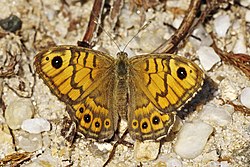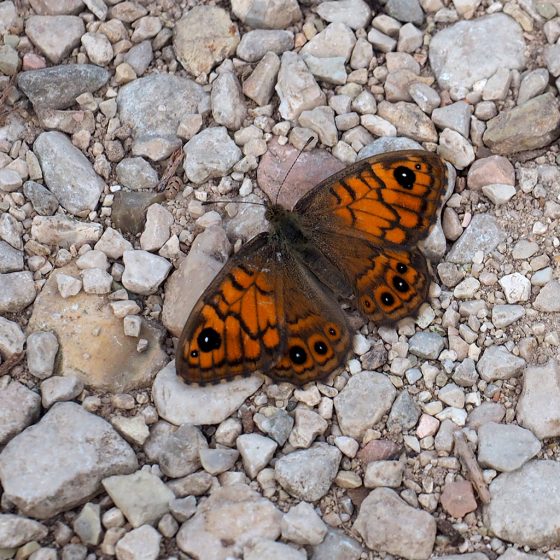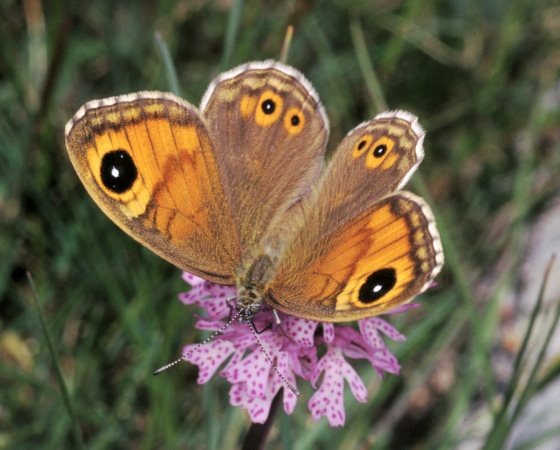Lasiommata megera – Linnaeus, 1767
Descrizione
Farfalla diurna della famiglia dei Ninfalidi.
È una farfalla dal volo fluttuante che ama posarsi al suolo per farsi scaldare dai raggi solari.
Si caratterizza per la faccia superiore della ali di colore arancio-marrone, con ocelli neri e macchia bianca centrale, attraversata da una linea zigzagante che è la parte più evidente e importante di un disegno scuro incrociato.
Ha due-tre generazioni annuali.
Lo sfarfallamento avviene da marzo-aprile a settembre-ottobre.
Specie presente in tutta l’Italia continentale, in Sicilia e in tutte le isole italiane ad eccezione di Sardegna, Capraia e Montecristo, dove è sostituita da L. paramegaera.
Si rinviene dal livello del mare fino a 2.500 metri di quota.
Specie simile
Lasiommata maera – Linnaeus, 1758
Come riconoscerle:
- Lasiommata megera presenta sulle ali anteriori una bella linea zigzagante di colore molto scuro e sempre ben evidente; tale linea sul rovescio delle ali è assente
- Lasiommata maera ha un disegno delle ali anteriori meno articolato e complesso. La linea zigzagante è spesso meno netta e scendendo tende a schiarire e a scomparire; sul retro delle ali la linea è sempre presente e di colore bruno-arancio più chiaro
Galleria
 Link da Moths and Butterflies of Europe and North Africa [www.leps.it]: Lasiommata megera – Linnaeus, 1767
Link da Moths and Butterflies of Europe and North Africa [www.leps.it]: Lasiommata megera – Linnaeus, 1767
| Wall brown | |
|---|---|

| |
| Male Sorrento Peninsula, Italy | |

| |
| Male Pewsey Downs, Wiltshire, UK | |
| Scientific classification | |
| Domain: | Eukaryota |
| Kingdom: | Animalia |
| Phylum: | Arthropoda |
| Class: | Insecta |
| Order: | Lepidoptera |
| Family: | Nymphalidae |
| Genus: | Lasiommata |
| Species: | L. megera
|
| Binomial name | |
| Lasiommata megera | |

Chemnitz, Germany

Scratchbury and Cotley Hills SSSI, Wiltshire
Lasiommata megera, the wall[1] or wall brown, is a butterfly in the family Nymphalidae (subfamily Satyrinae). It is widespread in the Palearctic realm with a large variety of habitats and number of generations a year.
Description
P. megera L. [— xiphie Boisd. pt (45d). Above reddish yellow, with a black mark which traverses the distal band from the cell of the forewing to the abdominal margin of the hindwing, short black stripes crossing the disc and the cell of the forewing.[2]
Range
The species lives in North Africa, Europe, the Caucasus, Asia Minor, the Middle East, western Siberia, northern Tian Shan, Dzungarian Alatau, Kazakhstan and Dzungaria.
Habitats
Habitats include forest edges and clearings, shrubby areas in ravines and river valleys and sparse woodlands. It is also found in mountain habitats up to 0–3,000 metres (0–9,843 ft) above sea level.

Life history
The imago flies from April to October in two or three generations depending on locality and altitude. The larva feeds on grasses in the genera Festuca, Bromus, Deschampsia, Poa, Dactylis and Brachypodium.
"The egg is pale green when first laid, and in shape it is almost spherical, but rather higher than broad; it is finely ribbed and reticulated, but unless examined through a lens it appears to be quite smooth. The caterpillar when full grown is whitish-green, dotted with white. From the larger of these dots on the back arise greyish bristles; the three lines on the back (dorsal and sub-dorsal) are whitish, edged with dark green; the line on the sides (spiracular) is white, fringed with greyish hairs; anal points green, hairy, extreme tips white. Head larger than the first ring (first thoracic segment), green dotted with white and hairy, jaws marked with brownish. The chrysalis is green, with yellow-tinted white markings on the edge of the wing covers and ridges; the spots on the body are yellowish, or sometimes white. Occasionally the chrysalids are blackish, with white or yellow points on the body". (South 1906)
Subspecies
- L. m. megera
- L. m. vividissima
- L. m. megerina (Herrich-Schäffer, 1856) – Transcaucasia
- L. m. transcaspica (Staudinger, 1901) – Turkmenia
-
Lasiommata megera megera ♂
-
♂ △
-
♀
-
♀ △
Size
Size: 36–50 millimetres (1.4–2.0 in)
References
- ^ Wall at UK Butterflies
- ^ Seitz. A. in Seitz, A. ed. Band 1: Abt. 1, Die Großschmetterlinge des palaearktischen Faunengebietes, Die palaearktischen Tagfalter, 1909, 379 Seiten, mit 89 kolorierten Tafeln (3470 Figuren)
 This article incorporates text from this source, which is in the public domain.
This article incorporates text from this source, which is in the public domain.
- "Lasiommata Westwood, 1841" at Markku Savela's Lepidoptera and Some Other Life Forms
- butterfly-guide.co.uk Archived 2019-07-22 at the Wayback Machine
External links

![Lasiommata megera, megera [da wikimedia, foto di Jörg Hempel, CC BY-SA 3.0 de,commons.wikimedia.org/w/index.php?curid=27765420]](https://www.montagneaperte.it/ambienteebiodiversita/wp-content/uploads/sites/9/2016/11/1024px-Lasiommata_megera_LC0311-wikimedia-560x560.jpg)





